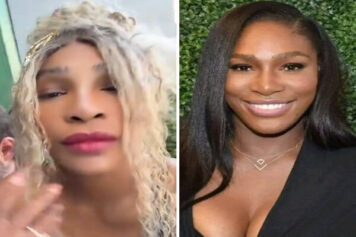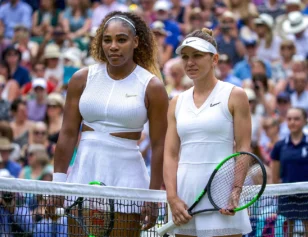Historically white activities.
Non-traditional participants.
Serena Williams and Misty Copeland are the faces of their respective professions in the United States.
Williams is the face of American tennis (men and women) while Copeland is the face of American ballet. Both came from humble beginnings in California. Both took unique paths into their professions. Both faced historical, racial and occupational obstacles. Both have dealt with negative commentary about their anatomies.
And both have overcome every challenge along the way to achieve the highest pinnacle of their vocation. In traditionally white professions.
**
Serena Williams is the #1 women’s tennis player in the world. With her victory yesterday at Wimbledon, she now has 21 major titles to her name and is only four behind Margaret Court’s record of 24, putting her in the discussion of GOAT status.
Mention American tennis and most automatically think of Serena Williams. Powerful, mentally tough and sometimes controversial both on and off the court, Williams has long had her detractors. Her father, Richard, groomed Serena and her sister Venus for tennis stardom. But they didn’t get their start in the academies of Florida. No, he started them on the municipal courts in Compton.
Serena didn’t look like anyone else on the tour, save for her sister Venus. Even then, however, Serena’s build was vastly different from Venus. She was muscular whereas Venus was svelte, like many other tennis players. Serena didn’t fit the mold of what a top tennis player looked like. She had to watch Venus win a major first. She had to watch Venus rise to #1 first.
Yet, Serena still believed in herself.
**
Misty Copeland was just named a principal at the renowned American Ballet Theatre (ABT). She is the first African-American female dancer to achieve that position in the company’s 75-year history.
Copeland is a rising star in American culture. I Will What I Want, the 2014 video ad from Under Armour, made her a household name outside of ballet circles. In the ad, a voice speaks rejection as Copeland slowly rises to point wrong body features, wrong age the voice says, all of which echoes her start into the world of ballet.
Misty didn’t look like any other ballerina when she started her rise. Most young girls start taking ballet in the single digit age range. Not Copeland. The ripe, old age of 13 is when her adventure began – an adventure that included calling a motel room home and a custody (emancipation) battle involving her mother and her first ballet instructors.
At the age of 19, her body transformed into a powerhouse of beauty, not your normal description of a ballerina. The once promising young prodigy had become a woman. As she said in her book, Life in Motion: An Unlikely Ballerina, I was heavier and I had a very full bust. It was a womans body, and it felt unfamiliar. I soon realized the ABT was searching for the little girl that I had been.
Yet, Misty still believed in herself.
**
Before rising to the top of the tennis world, Serena had to first overcome the mental side of tennis. She had the physical side. Fast serve, quick reflexes and tremendous court coverage. But, the mental side was different. In tennis, you have two opponents: across the net and self.
I’ve won probably most of my matches, probably all of my Grand Slams, because of upstairs (pointing to her head) not because of anything else, said Williams in a Sports Illustrated video from May. It’s how you play on a court, how you handle the different calls and most of all how you’re able to get into your opponent’s head and make them think they’re not going to win today.
Before rising to the top of the ballet world, Misty had to first overcome the mental side of ballet. The mental side of ballet is the discipline’s little secret: fitting the perfect, physical mold. Much like athletes in sports, ballerinas are finely in tune with their bodies: strengths, weaknesses, aches, growth, loss. Misty went through a period of battling her body, no longer perfect in the eyes of some ABT staff, which led to doubt. Doubt about her place in ballet. With the help of friends and a renewed mental strength, she learned to live within her body and adapt to its new strength.
**
Serena Williams and Misty Copeland are today’s trailblazers. Each has shown that success isn’t dictated by one’s physical image. It isn’t dictated by skin color or familial background. Success is dictated from within. Wrong body type? Wrong skin color? That just fuels their hunger. Tell them they can’t do something they’ll do it anyway. To prove to themselves they can, not to anyone else.
They each have an innate ability to overcome history’s expectations. Society’s history said they didn’t belong. Factual history said they did because of their trailblazers. Ask Serena and Misty and they will tell you that there were others who paved the way they now travel. Althea Gibson was the first African-American of either sex to win a Grand Slam tennis event when she won Wimbledon in 1956. The first black ballerina is how Raven Wilkinson was described as part of the Ballet Russe de Monte Carlo. Both faced all of the racism and discrimination of 1950’s and 60s America.
And lived to tell about it.
Serena and Misty don’t have to endure that level of adversity. Just because racism isn’t overt like in the past doesn’t mean it still isn’t prevalent today. In today’s social media age, perhaps there’s even more eyes on them than Gibson and Wilkinson. Nearly every single detail of a public figure’s life comes under scrutiny. When they falter, silent hearts lie in wait to pounce behind keyboard pulpits. When they succeed, strangers cheer in the synchronous clicks of Enter.
For as Gibson and Wilkinson did before them, Serena Williams and Misty Copeland are blazing the trail for the youngsters of today, especially those of color.
When society said “no”, Williams and Copeland said “yes”.





